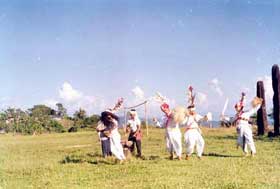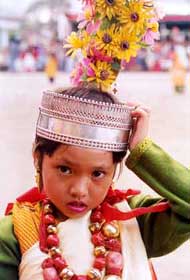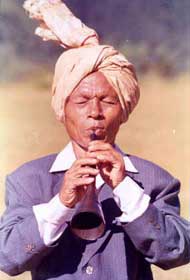Janapada Sampada
Miscellaneous Arts and Crafts in Meghalaya
Meghalaya is the abode of rhythm and dances. The dances are connected with their festivals or seasons and hence are to be enjoyed all year round. The bulk of dances are religious, social, agricultural, funeral and recreational.
The land reverberates with the sound of perfect rhythm, beautiful songs and traditional instruments. Dances are held in open. The following are the commonly known dances.

Rongkhli dance
Noh k jot It is prelude to a celebration which begins as a thanks-giving when dancers all men, clad in their dress and ornaments, armed with sword on the right hand and u symphia( a brush made from the hair of white muskin) on the left, commence by bowing down with the sword and symphia stretched out thrice

Mastiah

Traditional Dance
Only two men participate in rhythmic motion, by heeling and stepping out faster and briskly. The dancers holding firmly the sword and sympiah, dance with appropriate gesture and posture. They demonstrate the run-up in a chase and when winding up, they draw themselves closer to each other, bending down their bodies with the sword lowered, the swords then clumped in their hands, they bow down thrice among themselves like saluting reciprocally. ( The symphiah when swayed seems to indicate averting some impediments and sword held in hand and briskly shaken, their ever readiness to strike at some adversaries, both physical and moral.)
The mastiah performed as religious is different from mastiah thma, a war like dance where dancers demonstrate a kind of combat or a duel.
Shad pyllun
This is a big group dance where man and women dance together. Women dance in a slow motion because they dance, crawling on with their toes, taking three steps forward then carrying themselves backward by the heels. Men, however make the faster steps stepping in and out coming closer to the women, continuing this move then darting away and keeping on this position round and round in the circle.They hold aloft their sympiah when inclined and wave it when reclined.
Shad wait
This is sword dance which toward its close, ends in a crossed motion among two or four dances, two formed in a row maintaining their position and ending in a reciprocal close up of two dancers in each row. It is started by the dancers casting out three steps forward by their right foot, then receding. Each pair of dancers then celebrate a chase, round the circle holding the sword occasionally stretching out or brandishing it one man running forward and one from behind and complete the chase for three round, changing direction. The whole process is repeated thrice before winding it up.
Shad Iynti
is a march dance. Dancers while marching wave their swords and sympiahs. Flutes and drums are played in the background. Usually this kind of dance is performed during state receptions or other celebrations.
Shad nguh
This dance is also held during state reception or inspection. To make it courteous and befitting, the dancers on making the usual steps in a brisk movement finally approach the royal guest, bend their bodies, clasping the thuias( a plume of birds feathers) on both their hands bow down thrice demonstrating it with their bodies and hands.
Shad thma
The pair of dancers armed with sword and the shield, chase and combat by skirting off to directions right and left stepping up and pacing up appropiately with the balanced posture. After completing a round, they come close, strike each other with swords or shield. Then run chasing each other and finally wind up by bowing down at each other.
Lah- ho
It is one of the principal dance of the highlanders. In the eastern Jaintia region it is presented as an informal programme, the dance precludes women and is performed as a recreational programme , mostly boys participate forming two rows clasping hands over each other`s shoulders presenting the rhythmic movement in which they make few exchanges of words.
Shad lukhmi
A group dance in which a row of men take up position with women in alternate succession crossing hands over each other`s waist demonstrating a group motion in direction north to south and vice-versa. The shield used is very small and is not the same used for martial dance.
These dances are performed at the field depicts the different phases of cultivation.
Tu hali – creates a scene of women constructing or renovating the bunds or level lines of irrigated rice lands where a group of men nearby are ploughing the field.
Krut Kba highlights men and women at work gently dropping the hoes, striking the ground, then raising them back to the tune of instrumental and vocal music in the background.
Lur masi is driving the bullocks for ploughing , in a series of song and dance.
Sympat kba is a ceremonial threshing of the sheaves of grain on stone.
Rwai shoh kba is a harvest songs sung by groups jubilantly.
Dressing up and wearing ornaments forms important component of not only dance but daily life as well. The items turned out from the richest metals reveal the intricate system of folk jewellery in the state. Perhaps metallurgy was practised extensively in the past.
Some of the ornaments worn by females are as following-
a) Coronet-Ka pangsngiat – a crown in pure gold or silver with a flattened top which varies in shape between oval and round.
b) Wahdong – round earrings of pure gold which are like chains, the top most ends converging with the upper portions of the ear.
c) Siar Kynthei – earring bedecked in the ear-lobes and looping down. It must be of pure gold.
d) Lakyrdeng – for earlobes, of gold.
e) Ki tad ki mahu – bracelets of gold.
f) Khadu syngkha – bracelets of gold, very thick and heavy.
g) Shah ryndand – necklace of gold, tightened to the neck.
h) Kynjri tabah – bands of silver worn down from the neck.
i) Kanupad – coral beads and water pearls of reddish radiance but half of them being modelled in pure gold.
a) Kynjari-silver chains
b) Coral beads-half of which in the band are pure gold.
c) Wrislets in pure gold
d) Siar shynrang-earring of gold to distinguish from siar kynthai of women
e) A sword belt and scabbard in pure and plaited of silver on which the sword is hung.
f) Quiver- of silver on which three arrows are placed.
Some of the traditional – ornaments of Garos
a) Nadirong – It is a small brass ring worn in the upper part of the ear. It is worn both by men and women.
b) Nadongbi or Otongga – It is a brass ring worn in the lobe of the ear.Some men wear it as many as 30 to 50 in each ear. The women wear Nadongbi much larger in size and usually 12 to 20 in one ear.
c) Ripok or Necklaces – A special kind of necklace is made of long barrel-shaped beads of cornelian or red glass.Other kinds are made of brass or silver and are worn on special occasion.
d) Nataspi – A string of beads about four inches long ending in a semi-circular piece of brass, silver or crystal which is worn on upper part of the ear.

Traditional instruments
Musical- instruments have their own importance. They are used in dance, vocal singing, demonstrations and devotional performances. Playing of instruments varies according to time and place. Like drumming is a popular art and largely used for sacred and devotional music, yet the different styles and the types used, connote different meanings. Ksing lum paid is one kind of drum which is beaten to signal the begining of the dance. Ksing Dum Dum is used for counselling young ones so on. Following are the instruments used by Garo community. These instruments are manufactured by them and are composed of different kinds of drums, bamboo and horn wind instruments, gongs and cymbols. The Gambil (Gareya arborica) tree is used for making frames of the drum.
Dama
It is a long, narrow drum, thickest in the centre and tapering away at each end. It may be of 4 to5 feet long and is made out of wood.
Kram
It is a larger drum than a Dama. It is made out of wood with both ends covered with cowhide. The Kram is larger at one end and tapers away to a much smaller size at the other. They are used only on solemn occasion such as funeral and some annual ceremonies of a religious nature, while the Damma may be used any time. The Kram may not be taken out of the owner`s house except on certain important occasions, or else it is believed by the Garos that some misfortune may befall the owner.
Nagra
It is a large drum consisting of earthenware pot covered with cowhides. It is beaten only to call the people to assemble at the Nokma`s house when he calls them for feast or entertainment. The Nagra is a sacred possession and can be possessed only by the Nokmas, as such, it cannot be taken out of the house of the Nokma. The Garos believe that if somehow, the Nagra is taken out of the Nokma`s house, ill-luck is certain to visit the owners. The Nagra can be beaten only by the owners or by one of his relation, and not by any one else.
The Trumpets
There are two kinds of Garo trumpet played in accompaniment of the drums.
a) Adil- It is a small trumpet made out of the top of a buffalo`s horn to which a bamboo mouth-piece is attached. It is about six inches long.
b) Singga- It is merely the whole of the buffalo`s horn, and can produce sound only two or three times at one breath.
The flutes
All Garo flutes are made of bamboos only. There is no decoration or inscription on them.
a) Otokra- It is a big bamboo flute about 3 feet long and one inch in diameter, with only two finger holes.b) Illongma- It is a small bamboo flute with three steps only.
c) Bangsi-It is much smaller flute than others with three notes.
d) Imbingi- It is another kind of flute made out of a short piece of thin bamboo, closed at one end and open at the other. The outer hard covering of the bamboo is pooled off, leaving the softer white part below. The mouth -piece is a square hole about half an inch from the top of the closed end. From the mouth-piece downwards a small slip or tongue is cut in the upper surface of the peeled bamboo, by slitting it down on both sides to a distance of about half an inch.
Gongmina or Jew`s Harps
The Jew`s harp is made out of a thin slit of bamboo about 4 inches long and half an inch wide. It is so cut that a thin tongue runs down the centre of the slip connected there with at one extremity only. One end of a short piece of string is fastened to Jew`s Harp, and to the other end, a small bamboo handle is attached. The instrument is held between the thumb and forefinger of the left hand, placed between the teeth so that they touch it lightly, and the string is given a succession of sharp tugs by means of the handle in the right hand.
Rang or Gongs
The Rangs or Gongs are brass or metal plates or basin. They are used for various purposes by the Garos. They are played as a musical instruments during the dances and festivals. They are also used as a gold reserve, because a man`s wealth and social standing are measured by the number of Rangs one possesses. A dead Nokma is laid out before the cremation on rows of these gongs. In cases of legal disputes, the guilty has to pay the fine in terms of Rangs.These gongs acquire value with age.
Cymbals
There are two kinds of cymbals used by the Garos. They are the following.
a) Kakwa- It is a cymbal very similar to those used in the plains by the Hindus.b) Nenggilsi- It is a smaller cymbal than the former. It resembles two small cups of brass. These cymbals are used by hitting against each other in tune with other instrument.
Apart from these instruments played by the Garos there are other instruments as well. There are various kinds of drums like Kynphong, Naila and Padiah. They are normally oval although few are slightly bent from the middle to their heads shaped like a cucumber. The wood frame is hallowed from tree cutting, having been properly dried and oiled, their heads kept bare, then filled with sheets of skin. These drum in all cases are suspended from the two sides of the shoulder to the chest by a cord and a drummer plays by beating with hand upon its heads.
Like drums there are different kinds of Harps such as Singdiengphong, a primiative harp which bears eight strings modelled from the soft bamboo from the soft bamboo barks or reeds. Diengphong is played as an accompaniment to the songs or a tune.

Tongmuri
It played by beating upon its strings and joints on the border by a light bamboo or wooden chip. The other harps are the Maryngod, the sarong, the Marynthing and the Duitara. Marymgod and Sarong are similar in shape but Maryngod is an amalgamated thick wood coating where the fingers of the right hand strike and the left touching the strings changing and playing the tune.Duitara is thin where its small hollow rectangularly framed, the wooden bar holding the pegs being slightly lumpy. It has four strings. The roundback is patched with a piece of goat`s skin.
Tangmuri is common flute used at dances and processions. It has a horn spanned out like a cup and a base behind, on its upward surface are seven holes. The sharati is another flute, having some eight large holes. Its noisha is slightly bend.Tanglod is a flute having both the noisha and read affixed to it. Besli is a pipe reduced from a thin bamboo cut amid the two joints, its bark being properly scrapped with six or seven holes bored into its surface and is just like the chuwiang which has eight holes.
Trumpets mainly are the Ronsing and the Turoi. Ronsing is a buffalo`s horn naturally bended, the inside is hallowed and small opening is made on its two end. Turoi is a trumpet made of solid brass more elongated bending upwards having broad rim.
There are few cymbals used in which the Kynshaw is made up of two copper flat plates( with some dots and marks engraved upon its surface).The Majra is made from brass has two curved or pointed plates. They are played by striking them together with drums and flutes at big dances.




